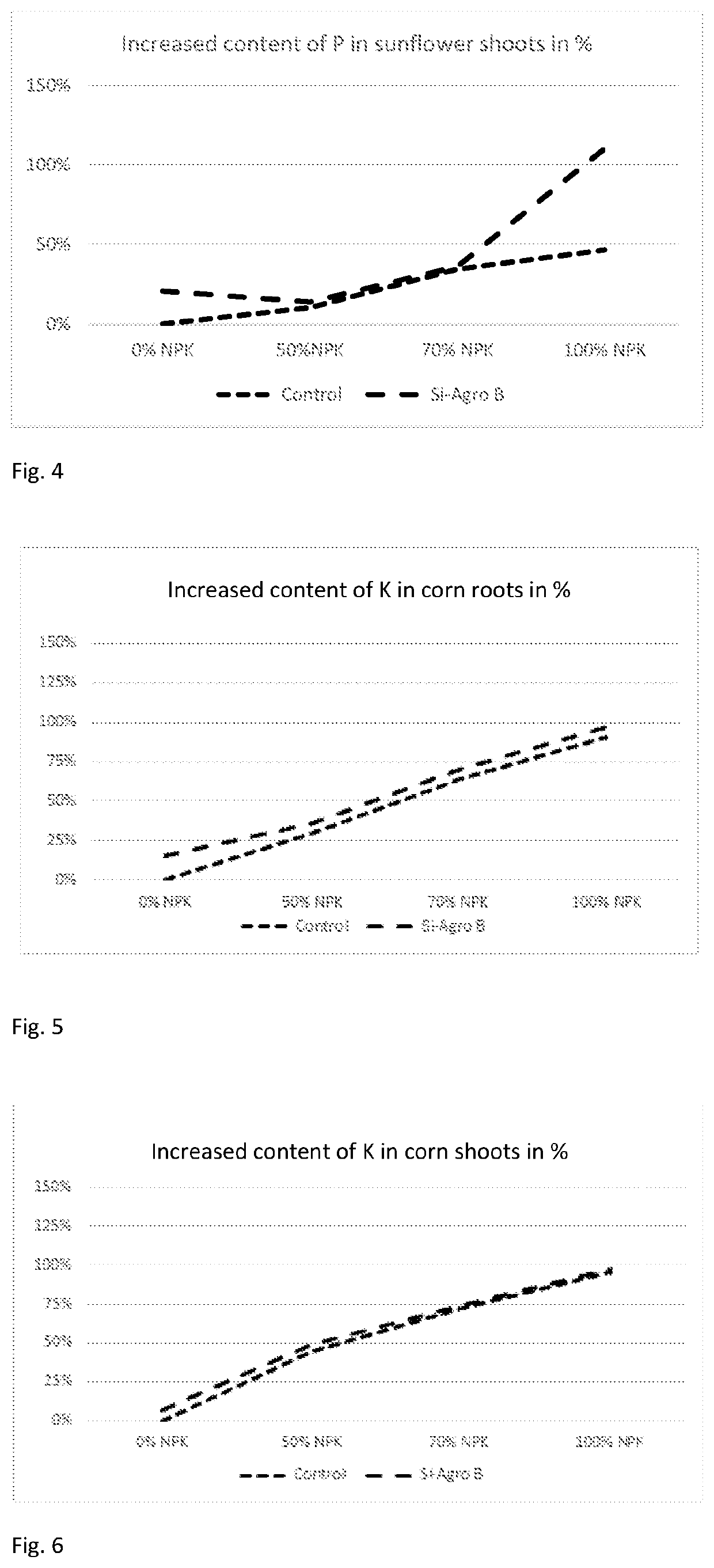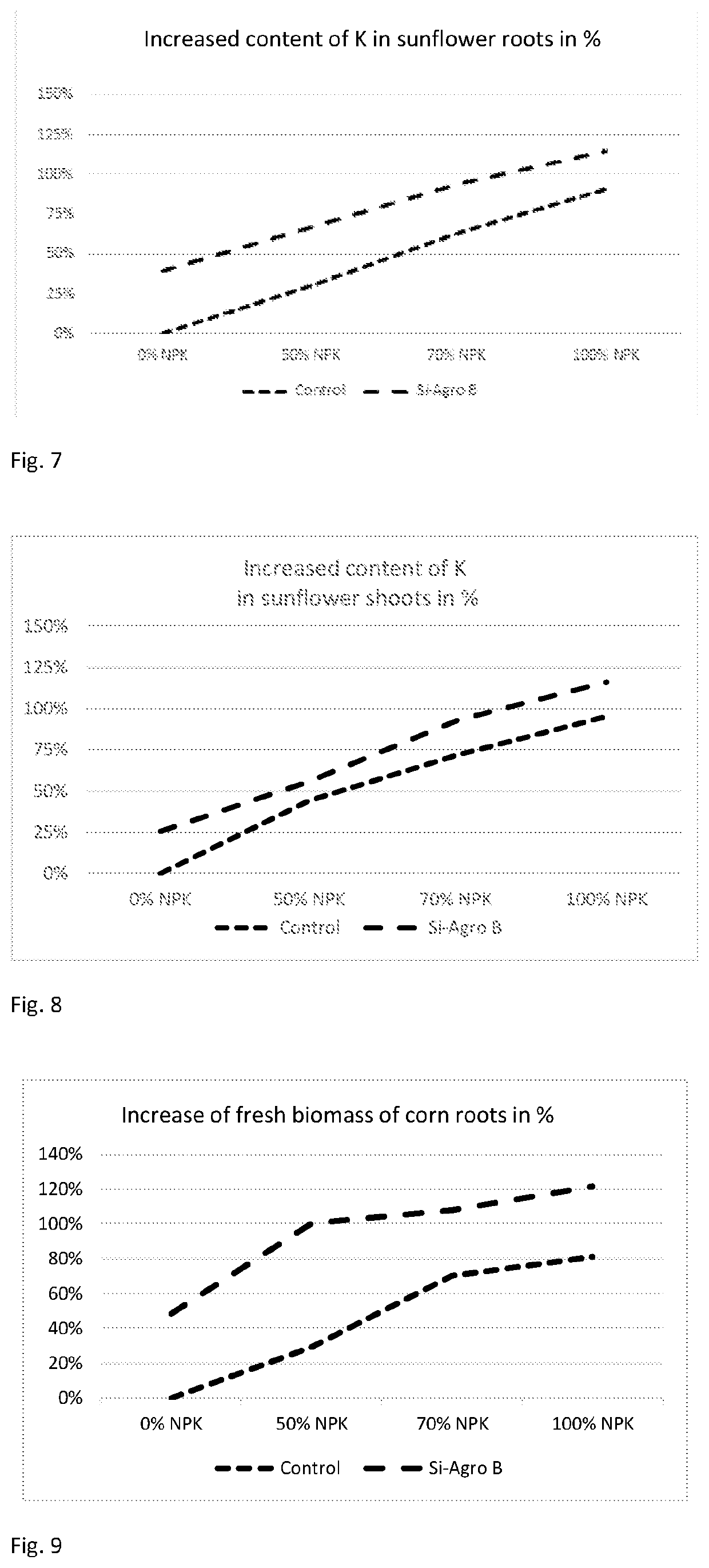Npk-si fertilizer, method for production and use thereof
a fertilizer and npk technology, applied in the field of npksi fertilizer products, can solve the problems of reducing the biota population and diversity of soil, and reducing the ph of soil, so as to achieve cost-effective and simple distribution and use
- Summary
- Abstract
- Description
- Claims
- Application Information
AI Technical Summary
Benefits of technology
Problems solved by technology
Method used
Image
Examples
example 1
Phosphorous
[0112]In the following tests the plant uptake of phosphorous (P) was measured. The amount of P was measured on corn and sunflower, in the roots and in shoots (stem and leaves).
[0113]Each table include a control test showing the uptake after applying 0 wt %, 50 wt %, 70 wt % or 100 wt % of NPK. 100 wt % NPK is equivalent to 300 kg / ha of NPK and 50 wt % is equivalent to 150 kg / ha of NPK. The tests where MS was added are generally denoted as “Si Agro B” in the tables below and in the accompanying drawings. The Si Agro B tests show the uptake of P in roots and shoots after applying 300 kg / ha of MS and 0 wt %, 50 wt %, 70 wt % or 100 wt % of NPK. 100 wt % and 50 wt % NPK is equivalent to 300 kg / ha and 150 kg / ha of NPK, respectively.
[0114]The numbers in the column “Increased P in wt %” shows the wt % increase in uptake of P (elemental P) in roots and shoots, respectively. The numbers are always compared to the results obtained with the Control when 0% NPK is applied. As an exam...
example 2
[0119]In the following tests the plant uptake of potassium (elemental K) was measured. The tests according to the present invention are denoted as “Si Agro B” in the tables below and in the accompanying drawings. The amount of K was measured in corn and sunflower, in the roots and in shoots (stem and leaves). The tables should be read the same way as explained above for the measurements of P uptake.
TABLE 6K uptake in corn roots.Treatment of cornmg K per kgRelative usageof dry rootsIncrease of K in wt %of NPK0%50%70%100%0%50%70%100%Control0.330.130.540.63 0%30%64%91%Si Agro B 0.380.450.560.6515%36%70%97%(300 kg / ha MS)
TABLE 7K uptake in corn shoots.Treatment of cornmg K per kgRelative usageof dry shootsIncrease of K in wt %of NH0%50%70%100%0%50%70%100%Control0.430.620.740.840%44%72%95%Si Agro B 0.460.640.750.857%49%74%98%(300 kg / ha MS)
[0120]As seen in tables 6 and 7, (also refer to FIGS. 5 and 6) NPK usage increased the K content of the corn with 91% in the roots and 95% in t...
example 3.examples
Example 3. Examples of Increased Biomass
[0125]Greenhouse tests for growth of corn root and shoot biomass were performed. The tests according to the present invention are denoted as “Si Agro B” in the tables below and in the accompanying drawings.
TABLE 10Biomass of corn roots.Treatmentof cornBiomass gramper plantIncreased Relative Biomass of Roots:biomass in wt %use of NPK:0%50%70%100%0%50%70%100%Control4.545.877.73 8.22 0% 29% 70% 81%Si Agro B 6.749.1 9.4410.0648%100%108%133%(300 kg / ha MS)
TABLE 11Biomass of corn shoots.Treatment of cornBiomass gramper plantIncreased Relative useBiomass of Shoots:biomass in wt %of NPK:0%50%70%100%0%50%70%100%Control4.786.22 7.34 8.27 0%30% 54% 73%Si Agro B 7.1 9.3310.7510.9549%95%125%129%(300 kg / ha MS)
[0126]By use of NPK the root biomass increased by 81%, see table 10. Less use of NPK gave relatively less biomass. Use of MS (300 kg / ha) resulted in 48% root biomass increase, without the usage of any NPK. With use of 100% NPK together with MS the root ...
PUM
 Login to View More
Login to View More Abstract
Description
Claims
Application Information
 Login to View More
Login to View More - R&D
- Intellectual Property
- Life Sciences
- Materials
- Tech Scout
- Unparalleled Data Quality
- Higher Quality Content
- 60% Fewer Hallucinations
Browse by: Latest US Patents, China's latest patents, Technical Efficacy Thesaurus, Application Domain, Technology Topic, Popular Technical Reports.
© 2025 PatSnap. All rights reserved.Legal|Privacy policy|Modern Slavery Act Transparency Statement|Sitemap|About US| Contact US: help@patsnap.com



